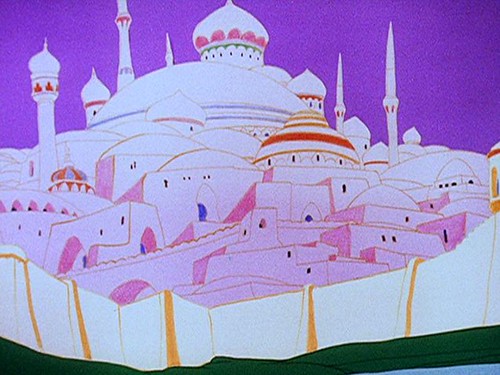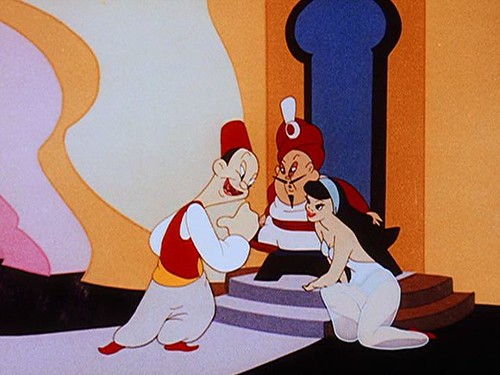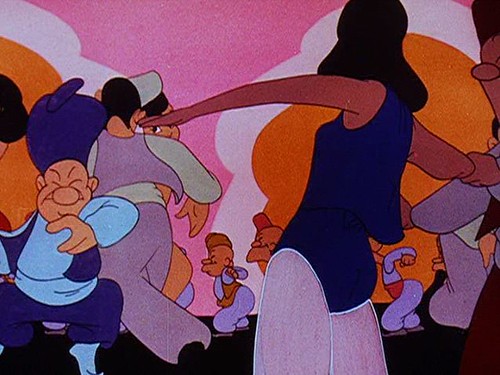Another working paper on a classic Walter Lantz cartoon from the 1940s. Download from:
Abstract and Introduction below:
Abstract: The Greatest Man in Siam is a Walter Lantz cartoon from 1943. It has a pseudo-Oriental setting and depicts a contest to win the hand of a young princess. The losers present themselves as intelligent, rich, and athletic, respectively, while the winner is a good musician and dancer. He’s also the only one who plays attention to the princess and doesn’t insult the king. The cartoon ends with everyone dancing, thus affirming communal values over individual accomplishment. Just before the end there is a virtuoso dance sequence between the couple; it was superbly animated by Pat Matthews.Contents:Introduction: What Fun! Learning to See 1The Hottest Man in Siam 4The Greatest Social Contract in Siam 18Why Siam? The Contest Motif 32The Phallus in the Palace 34Eyes, Electricity, and a Contest 38In Praise of Cartoons: Lantz Does Conceptual Integration 45The Siam Paradox 54Shamus Culhane of the Avant-Garde 55
Introduction: What Fun! Learning to See
This cartoon gave me a great deal of pleasure. Above all, there is the dance sequence, which is flat-out joyous wonderful. Then there is the anonymous solo trumpeter on the sound track, who just kills it! I’ve rarely heard such heart-felt and enthusiastic playing on the sound track of any film. As I’m a trumpet player myself, I suppose I get more of a kick out of the trumpeting that most would, but the player’s passion is evident.
Then there is the chase, the intellectual chase. I didn’t start out to write a series of posts on The Greatest Man in Siam. At this point I don’t really remember just what I set out to do – though now that I’ve looked, I notice I’ve got some remarks about that in my initial post. About all I can remember is that, when I first decided to blog about it, I didn’t intend to write so very much about that dance sequence. But once I actually started planning the post, that was when I figured that I really needed to devote a whole post to nothing more than the dance sequence. I figured I could take care of the rest of the cartoon in another post.
It didn’t quite work out that way. Once I started digging I had to dig for more. It took me awhile to figure out what was going on in this cartoon. And then, when I was pretty much done The New York Times published an article about the cartoon’s director, Shamus Cullhane, pointing out that he consciously and deliberately slathered this cartoon in phallic symbolism.
I am, of course, aware that this cartoon reeks of sexism and Orientalism. The most obvious index of the latter is that, while this cartoon is located in a generic Middle East, it is said to be located in Siam, which is what Thailand was called until 1939. Surely that mis-location is more important than the fact that “Siam” was no longer current when the cartoon was made in 1943. And the sexism could hardly be more blatant: A woman is about to be wed to a man who wins a contest staged by the woman’s father. That’s patriarchy, with a vengeance.
If I don’t put those things front and center in my analysis and description it is not because I don’t notice them. They just aren’t what most interest me. They are aspects of the world in which the cartoons functioned, but I doubt that they are what most attracted people to this cartoon. They are simply background, enabling background perhaps, but nonetheless background.
The story in this cartoon needed to be set somewhere and the nature of the story – a contest for a woman’s hand – makes contemporary America an implausible location. So it was located in a generic Oriental place just to put it somewhere, but a place larded with contemporary allusions. We see “Lockheed vs. Kaiser Welders” on a theatre marquee and one of the suitors, a rich man, is caught violating war era rationing restrictions while another is hustled out to the draft board. And the music that propels the central dance number is contemporary swing of a high order.
Much of this is blatantly obvious, but the animation during that dance number is worth noting on the face of it. Not many animators could do that and Pat Matthews was notable as a specialist in such things. The logic of the contest, in contrast, is not so obvious. It took me awhile to figure out just why the trumpeter won the young woman’s hand. Yes, he’s a man of ordinary looks and physical proportions (he’s a bit bottom heavy) while she’s stereotypically good looking, so having him win gives romantic hope to men in the audience. But, and this is surely important, not only can he blow the trumpet with style and excitement, he can dance.
He’s the only one of the suitors who gets that far, to dance with her, and they dance very well together. He’s got the moves; she’s got the moves. Perhaps that’s why he was depicted as physically ordinary, to emphasize the moves. What’s not so obvious is that he’s the only one of the suitors who paid any attention to her; if you look closely you’ll see that she chose him. Moreover he’s the only one who didn’t interfere with her father’s vision.
All these things are obvious enough in retrospect, but teasing them out of the manifold exuberance of the cartoon was not easy. But it was fun. And it is the only way that we’re going to understand how these things are made. And by “things” I mean not only seven-minute cartoons, but also feature-length cartoons and live action films as well.
If we care about these things, these aesthetic objects, perhaps it is time we slow down and learn to describe them. We’ve become expert in interpreting and critiquing and that has led to an empty virtuosity where the terms of the analysis are more important than the objects of analysis. I would say that it’s time to return to basics, but the fact is there is little return involved. It’s not as though there was a time in past when we practiced the crafts of close analysis and description. There wasn’t. “Close analysis” of the literary kind was never that close and it was always in service to meaning. It is time we learned to see what’s there. Only then can we come to understand and explain it.



No comments:
Post a Comment